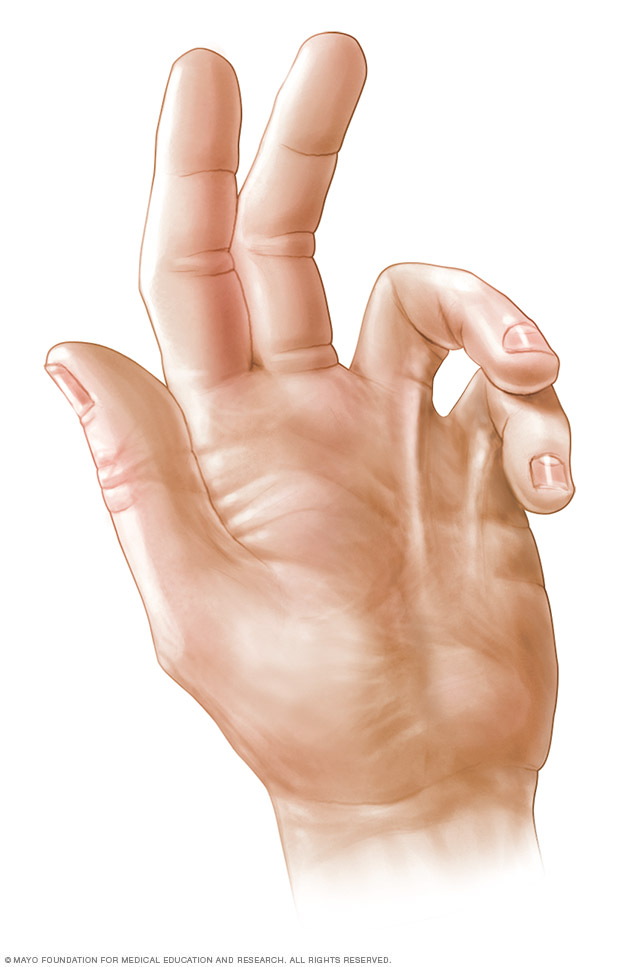Overview
Dupuytren contracture is a condition that causes one or more fingers to bend toward the palm of the hand. The affected fingers can't straighten completely.
Knots of tissue form under the skin. They eventually create a thick cord that can pull the fingers into a bent position. The condition gradually gets worse with time.
Dupuytren contracture most often affects the two fingers farthest from the thumb. This can complicate everyday activities such as placing your hands in your pockets, putting on gloves or shaking hands.
There's no cure for Dupuytren contracture. Treatments can relieve symptoms and slow how quickly the condition gets worse.

Symptoms
Dupuytren contracture gets worse slowly, over years. The condition begins with a firm lump in the palm of the hand. This lump can be painful or painless.
Over time, the lump can extend into a hard cord under the skin and up into the finger. This cord tightens and pulls the finger toward the palm, sometimes severely.
Dupuytren contracture most commonly affects the two fingers farthest from the thumb. The condition often occurs in both hands.
Causes
The cause of Dupuytren contracture is unknown. The condition tends to run in families. It’s more common in men than in women.
Risk factors
Risk factors for Dupuytren contracture include:
- Age. Dupuytren contracture occurs most commonly after the age of 50.
- Sex. Men are much more likely to develop Dupuytren than are women. In men, symptoms may be worse and progress more quickly.
- Ancestry. People of Northern European descent are at higher risk of the disease.
- Family history. Dupuytren contracture often runs in families.
- Occupation. Some studies show a connection between Dupuytren contracture and workers who use vibrating tools.
- Diabetes. People with diabetes have an increased risk of Dupuytren contracture.
- Tobacco and alcohol use. Smoking tobacco and drinking alcohol both increase the risk of Dupuytren contracture.
Diagnosis
In most cases, Dupuytren contracture can be diagnosed by the look and feel of the hands. Other tests are rarely necessary.
Health care providers compare the hands with each other and check for puckering on the skin of the palms. They also press on parts of the hands and fingers to check for hard knots or bands of tissue.
Another test for Dupuytren contracture involves putting the palm of the hand flat on a tabletop or other flat surface. Not being able to fully flatten your fingers means you might need treatment.
Treatment
If the disease progresses slowly, causes no pain and has little impact on your ability to use your hands for everyday tasks, you might not need treatment. Instead, you can wait to see if Dupuytren contracture progresses. You may wish to follow the progression with a tabletop test, which you can do on your own.
Treatment involves removing or breaking apart the cords that are pulling your fingers toward your palm. This can be done in several ways. The choice of procedure depends on the severity of your symptoms and other health problems you may have.
Needling
This technique uses a needle, inserted through numbed skin, to puncture and break the cord of tissue that's contracting a finger. Contractures often recur but the procedure can be repeated.
The needling technique has several advantages. There are no large cuts to heal. It can be done on several fingers at the same time. It can be done in the office setting instead of the operating room. A disadvantage is that it can't be used in some places in the finger because it could damage a nerve or tendon.
Injections
- Steroids. In the early stages of the disease, steroid injections into the hard lump may help soften and flatten it. These injections also may help relieve pain from the nodules.
- Collagenase. Injecting a special enzyme, called collagenase, into the hard lumps and cords can soften and weaken them. At a second appointment within the following week, your hand is moved in a way to break up the cords and straighten your finger. This can reduce or even eliminate the contracture for several years.
Surgery
People with severe symptoms may need surgery to remove the tissue that's bending the fingers. Surgery usually results in a more complete and longer lasting release than that provided by the needle or enzyme methods. But recovery takes longer.
In some severe cases, surgeons remove all the tissue likely to be affected by Dupuytren contracture, including the attached skin. In these cases, a skin graft is needed to cover the open wound. This surgery is the most invasive option and has the longest recovery time.
Any treatment of Dupuytren contracture may provide only temporary relief. The contraction of the fingers often returns with time.
Lifestyle and home remedies
If you have mild Dupuytren contracture, you can protect your hands by:
- Avoiding a tight grip on tools by building up the handles with pipe insulation or cushion tape.
- Using gloves with heavy padding during heavy grasping tasks.
Preparing for an appointment
Your health care provider might send you to see a bone surgeon. This is often called a referral to an orthopedic surgeon.
What you can do
Before your appointment, you might want to write a list that answers the following questions:
- Do you have a family history of this problem?
- What treatments have you tried? Did they help?
- What medications and supplements do you take regularly?
What to expect from your doctor
You might be asked:
- When did your symptoms begin?
- Have they been getting worse?
- Is your hand painful?
- How does the condition interfere with your day-to-day tasks?
© 1998-2025 Mayo Foundation for Medical Education and Research (MFMER). All rights reserved. Terms of Use


